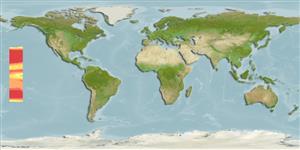>
Myctophiformes (Lanternfishes) >
Myctophidae (Lanternfishes) > Lampanyctinae
Eponymy: Dr Rolf Ling Bolin (1901–1973) was an American ichthyologist and marine biologist who was a specialist in lanternfish. [...] (Ref. 128868), visit book page.
Environment: milieu / climate zone / profondeur / distribution range
Écologie
marin bathypélagique; non migrateur; profondeur 40 - 850 m (Ref. 13608). Deep-water; 45°N - 40°S, 169°W - 153°W
Eastern Atlantic: single record at 45°41'N, 13°42'W (Ref. 4775); also between 14°N and 6°S. Western Atlantic: in tropical waters north to about 40°N; also between 34°S and 40°S (Ref. 4775). Western Indian Ocean: Agulhas Current (Ref. 4066) and at least between 28°S and 30°S. Eastern Indian Ocean: near Tasmania. Pacific: near Hawaii. Recorded in South China Sea near the Tungsha Islands (Ref. 39633).
Length at first maturity / Taille / Poids / Âge
Maturité: Lm ?, range 9 - ? cm
Max length : 11.7 cm SL mâle / non sexé; (Ref. 4479)
Description synthétique
Clés d'identification | Morphologie | Morphométrie
Épines dorsales (Total) : 0; Rayons mous dorsaux (Total) : 12 - 14; Épines anales: 0; Rayons mous anaux: 12 - 15. Total anal organs 8-10; three to 6 small elongate patches of luminous tissue along base of anal fin which originate at the 4th ray; supracaudal gland short, with 2-3 scales, infracaudal gland with 3-5 scales reaching below last or next to last posterior anal organ (Ref. 39633).
Body shape (shape guide): elongated.
High-oceanic species found between 375 and 750 during the day and between 40 and 650 at night (Ref. 4775). Mesopelagic (Ref. 75154). Large individuals are non-migratory (Ref. 4775).
Life cycle and mating behavior
Maturité | Reproduction | Frai | Œufs | Fécondité | Larves
Hulley, P.A., 1990. Myctophidae. p. 398-467. In J.C. Quero, J.C. Hureau, C. Karrer, A. Post and L. Saldanha (eds.) Check-list of the fishes of the eastern tropical Atlantic (CLOFETA). JNICT, Lisbon; SEI; Paris; and UNESCO, Paris. Vol. 1. (Ref. 4479)
Statut dans la liste rouge de l'IUCN (Ref. 130435: Version 2024-2)
Menace pour l'homme
Harmless
Utilisations par l'homme
Outils
Articles particuliers
Télécharger en XML
Sources Internet
Estimates based on models
Preferred temperature (Réf.
123201): 4.7 - 8.4, mean 6.2 °C (based on 4 cells).
Phylogenetic diversity index (Réf.
82804): PD
50 = 0.5078 [Uniqueness, from 0.5 = low to 2.0 = high].
Bayesian length-weight: a=0.00794 (0.00448 - 0.01409), b=3.20 (3.04 - 3.36), in cm total length, based on LWR estimates for this species & (Sub)family-body (Ref.
93245).
Niveau trophique (Réf.
69278): 3.1 ±0.1 se; based on size and trophs of closest relatives
Résilience (Réf.
120179): Milieu, temps minimum de doublement de population : 1,4 à 4,4 années (Preliminary K or Fecundity.).
Fishing Vulnerability (Ref.
59153): Low vulnerability (10 of 100).
🛈
